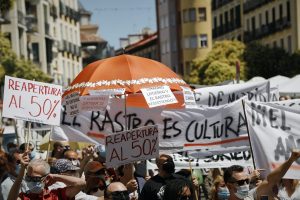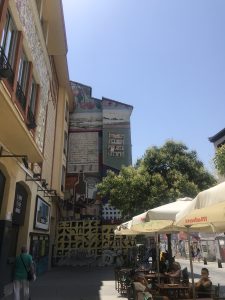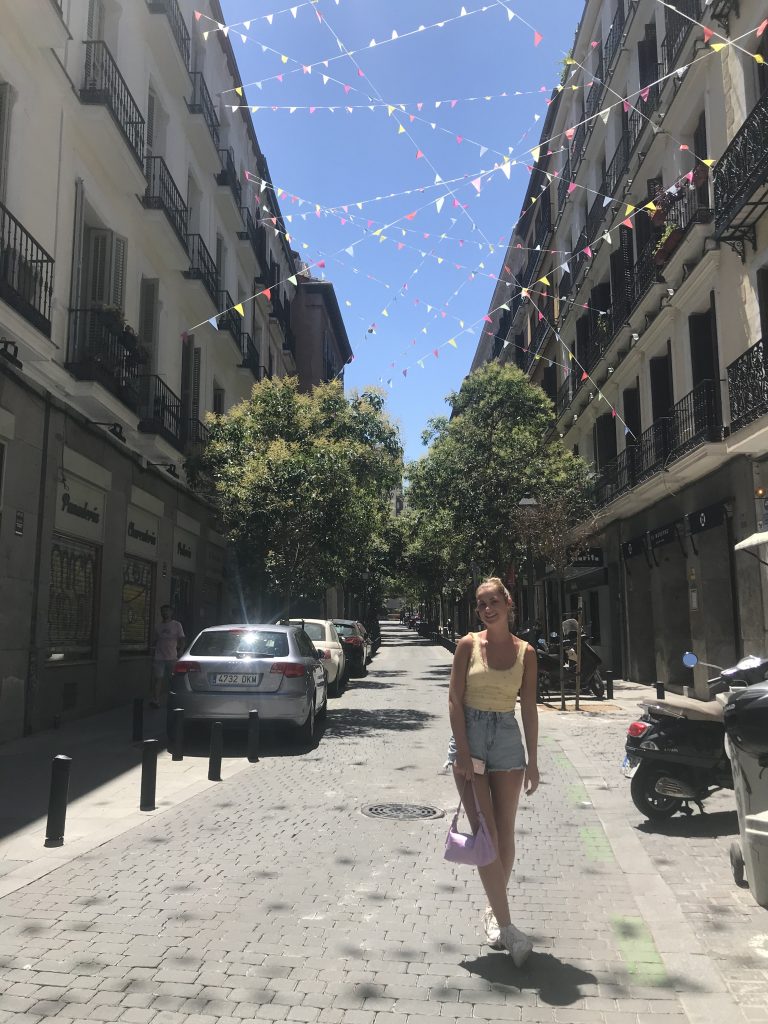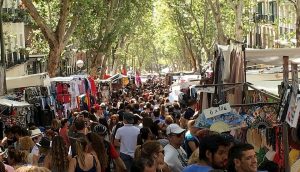
Las manifestaciones del Rastro
El Rastro es el mercadillo al aire libre más popular (y caótico) de España, que acoge a miles de personas cada semana y reúne a gente de todas las culturas, barrios y niveles de ingresos.
Se celebra todos los domingos y días festivos y está situado entre la calle Embajadores y la Ronda de Toledo en el centro de Madrid. Toda la calle se llena de vendedores ambulantes que venden casi todo lo que puedas imaginar. Cuando España entró en su primer confinamiento en marzo, el más duro de Europa, el Rastro fue cancelado por primera vez.
Hasta la pandemia, el Rastro había estado abierto todos los domingos por más de 400 años, sin importar el clima, ni siquiera la guerra civil lo interrumpió como lo hizo la pandemia. Aunque después de 5 largos meses, cuando regresó en agosto, no fue exactamente lo mismo. Usualmente vivo con músicos, turistas y vendedores callejeros, sólo 135 puestos fueron permitidos para volver cada semana en rotación de los cerca de 1.000 puestos que normalmente se instalaban cada domingo. Esto causó indignación entre los locales, ya que se permitía que las tiendas tuvieran hasta el 60% de su capacidad habitual en el interior, las restricciones alrededor del Rastro eran mucho más duras, a pesar de que el Rastro era al aire libre.

Este mercado es el medio de vida de la gente y lo ha sido durante generaciones, y sin él algunos no tienen otra fuente de ingresos. Por eso cientos de personas salieron a las calles a manifestar, insistiendo en que el 50% de los puestos se devolvieran a las calles de forma rotativa, para permitir una medida de seguridad adecuada y para que los titulares de los puestos mantuvieran los lugares que algunos de sus familiares han tenido durante generaciones. En un comunicado, un representante de los manifestantes dijo que el plan del consejo “será un desastre para los puestos históricos del Rastro, una pérdida de la identidad de uno de los lugares más emblemáticos de la capital, el lugar de miles de historias, poemas, retratos”. Dicen que, si desaparece, también lo hará “gran parte de la identidad de la ciudad y parte de su patrimonio histórico”.
Habiendo estado yo mismo en el Rastro muchas veces, sé lo único y especial que es. Es más que un mercado, es parte de la cultura e historia de Madrid.
Sin embargo, con muy poco acuerdo alcanzado, y Madrid siendo puesta en otro serio confinamiento, con la circulación dentro y fuera de la ciudad ya restringida y algunos bares y tiendas cerrando una vez más, el futuro de El Rastro es incierto.
El Rastro is the most popular (and chaotic) open air flea market in Spain, welcoming tens of thousands of people every week, and bringing together people from every culture, barrio and income bracket.

It is held every Sunday and public holiday and is located between Calle Embajadores and the Ronda de Toledo in the centre of Madrid. The whole street overflows with street vendors selling almost anything you can imagine. When Spain entered its first lockdown back in march, the toughest in Europe, el Rastro was cancelled for the first time.
Until the pandemic, el Rastro had been running every Sunday for over 400 years, whatever the weather – not even the civil war disrupted it like the pandemic did. Although after 5 long months, when it made its return in august, it wasn’t quite the same. Usually bustling with musicians, tourists and street sellers, only 135 stalls were allowed to return each week on rotation out of around 1,000 stalls which would normally set up every Sunday. This caused outrage with locals, as shops were allowed up to 60% of their usual capacity inside, the restrictions around el Rastro were a lot harsher, despite el Rastro being open air.
This market is people’s livelihood and has been for generations, and without it some have no other source of income. That is why hundreds of people took to the streets to protest, insisting 50% of the stalls were returned to the streets on a rotating basis, to allow for adequate safety measure and for the stall holders to keep the spots some of their family have had for generations. In a statement, a representative of the demonstrators said the council’s plan “will be a disaster for the historic Rastro stands, a loss of the identity of one of the most emblematic places in the capital, the place of thousands of stories, poems, portraits.” They say that if it disappears, so too will “much of the identity of the city and part of its historical heritage.”

Having been to el Rastro myself many times, I know how unique and special it is. It is more than a market it is a part of Madrid culture and history.
However, with very little agreement reached, and Madrid being placed into yet another serious lockdown, with movement in and out the city already restricted and some bars and shops closing once again, the future of el Rastro is uncertain.
